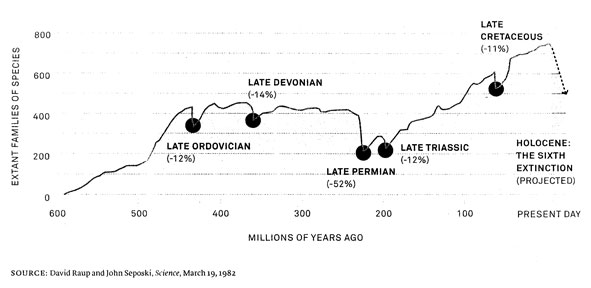Extinction: The great threat before us
by Patali CHAMPIKA RANAWAKA
The United Nations has declared 2010 as the World Biodiversity Year.
Its primary objective is to increase the public awareness of
conservation and restoration of biodiversity in the world. It is
estimated that nearly 750 families of species and approximately 1.7
million of diverse species belonging to these families are living on
this planet. However, it is very unfortunate to note that many of these
species are endangered or faced with the threat of extinction.
 |
|
Biodiversity |
Generally development is defined as an ever growing cycle of economic
production and consumption. Therefore, the yardstick with which
development is measured is based on economic and monetary terms. At
present, the GDP per-capita level of Sri Lanka is 2,200 US$ and its
corresponding world rank is 119. If this yardstick is modified
incorporating the Purchasing Power Parity (PPP), our GDP would be 5,000
US$ and out of 176 countries which possess reliable relevant data, our
corresponding world rank would be 112.
In order to provide a better estimate of development, incorporating
education and health as two additional parameters, the UNDP has
calculated the Human Development Index (HDI), and it elevates us to the
99th rank in the world. Subsequently, our Ministry was able to formulate
a new index incorporating GDP per-capita (PPP), health level, education
level, income distribution and poverty level, pollution and resources
base (ecological foot print and biodiversity). We termed it as
Sustainable Human Development Index (SHDI) as it provides a better
assessment and a wide picture on sustainability. This index (SHDI) ranks
Sri Lanka 27th and USA 94th in the world.
This clearly proves the fact that development is a another relative
concept and it is based on the yardstick with which it is measured and
further, we would be ranked 23rd in the world if biodiversity is used as
the yardstick to measure the development. So, if the per-capita GDP is
used as the yardstick to measure development, we are living in a
so-called third world country. However, if the yardstick is modified
incorporating other parameters like emission of carbon dioxide or
biodiversity, we are living in a first world country.
Biological Diversity, simply stated is the variety and variability
among living organisms and the ecological complexes in which they occur
and it has three major levels such as genetic, species and ecosystem.
Species are the building blocks of ecosystems and ecosystems provide the
life support systems for human beings.
Loss of biodiversity mainly means the loss or extinction of species.
Extinction has been a fact of life since life first emerged from the
primordial ages.
The present few million species are the modern day survivors of the
estimated several billion species that have ever existed.
All past extinctions have occurred by natural processes such as the
direct result of competition with superior species, or even if most
represented an inevitable failure to meet the challenges of minor
environmental changes. But many, if not most, extinctions are reactions
to environmental challenges so severe and unpredictable such as volcanic
eruptions, meteorite destructions and avalanches.
Currently, extinctions caused by human beings are decreasing the
Earth’s biological diversity at an unprecedented rate. Conservation
biologists estimate that species are presently becoming extinct at a
rate at least 100 times the natural rate of background extinction. More
than 31,000 plant and animal species are currently threatened with
extinction.
Although extinction is a natural biological process, it can be
accelerated greatly by human activities. What is important to consider
is that humans are making species to go extinct versus the natural
process of extinction is the rate at which humans cause extinctions
which is considered unnatural.
Usually, as one species is naturally evolving out of existence
another species is evolving as a replacement for that particular niche.
Humans cause extinctions so quickly that nature does not have time to
evolve something new to fill in the gap. Therefore, humans cause many
gaps to occur in ecosystems which disrupt the functioning of biological
processes that keep us all alive.
This is why biological diversity is so important. Diversity can buy
time so that a replacement species can be evolved. Thus, it acts like a
buffer so that the ecosystem does not respond to the gaps by immediately
collapsing. If that occurred, the life support systems would quickly
shut down and all of life would die.
The five major extinction episodes of life on earth can be
exemplified by the changes through geological time in family diversity
of marine vertebrates.(See Table 1)
Extinction rates are usually estimated indirectly from principles of
biogeography. The number of species of a particular group of organisms
in an island system increases approximately as the fourth root of the
land area. Using the above relationship ultimate losses due to the
destruction of rain forest in the new world tropical mainland can be
projected. If the present level of forest removal continue, the stage
will be set within a century for the inevitable loss of 12% of the 704
bird species in the Amazon basin and 15% of the 92,000 plant species in
South and Central America.
In general, the tropical world is clearly headed towards an extreme
reduction and fragmentation of tropical forests, which will be
accompanied by a massive extinction of species. At the present time less
than 7% of the forest are protected within parks and reserves globally
and even these are vulnerable to political and economic pressures.
Many published sources indicate that about 1.7 million living species
of all kinds of organisms have been described. Approximately 950,000 are
insects, 53,000 are vertebrates and 250,000 are plants.
 The remainder consists of a complex array of invertebrates, fungi,
algae and micro organisms. Most systematizes agree that this picture is
still very incomplete and that the number of species on earth is based
on the described fauna and flora. The idea of entomologists and tree
specialists is that the absolute numbers falls somewhere between 5 and
30 million. The remainder consists of a complex array of invertebrates, fungi,
algae and micro organisms. Most systematizes agree that this picture is
still very incomplete and that the number of species on earth is based
on the described fauna and flora. The idea of entomologists and tree
specialists is that the absolute numbers falls somewhere between 5 and
30 million.
Today threats to species and ecosystems are the greatest in recorded
history. Virtually, all of them are caused by human mismanagement of
biological resources, often stimulated by misguided economic policies
and faulty institutions that enable the exploiters to avoid paying the
full cost of their exploitation.
The marine fauna has been underestimated since many species traverse
along continental boundaries.
The new Worlds Register of Marine Species contains about 122,500
validated marine species names. Leading experts independently estimate
that about 230,000 marine species are known to science.
also believe there are three times as many unknown (unnamed) marine
species as known, for a grand total on earth that could surpass 1
million.
A species becomes extinct when the last existing member of that
species dies. Extinction therefore becomes a certainty when there are no
surviving individuals that are able to reproduce and create a new
generation.
A species may become functionally extinct when only a handful of
individuals survive, which are unable to reproduce due to poor health,
age, sparse distribution over a large range, a lack of individuals of
both sexes (in sexually reproducing species), or other reasons.
Functionally extinct species in modern times are the Baiji dolphin and
the South China tiger.
Many extinct species have had profound effects on other species
through their interactions. In themselves, these interactions or
functions are an integral part of biodiversity.In Sri Lanka, 21
amphibian species have been listed as extinct in the 2007 National Red
Data Book. Of these, two species have been re-discovered in 2009.
This may have been due principally since a thorough survey had not
been conducted for some time. Despite the fact that exact numbers are
not known for extinct flora and fauna (Jurassic, Miocene and Pleistocene
faunal lists are available but not for the Holocene period) what is
listed as Critically Endangered has the highest chance of becoming
extinct in the wild if conservation measures are not conducted.(See
Table 2)
The marine fauna of Sri Lanka has been the least studied. Therefore,
only approximate numbers can be given.(See Table 3)
Considering the plant species in Sri Lanka 71 species is considered
as extinct whilst one species is considered as being extinct in the
wild. Of the 1099 plant species evaluated for the 2007 redlist 251
species is considered as being critically endangered of this, 163
species are endemic to Sri Lanka.
The Global List contains very few of Sri Lanka’s threatened species.
This is principally since the total number of nationally threatened
species has not yet been included in the global list. In general,
globally, the Jurassic habitats and the Miocene marine environment have
become extinct. In Sri Lanka too, fauna that were described from their
fossils are no longer extant. But several species have sustained from
the Pleistocene such as the Acavus species whose genus is endemic to Sri
Lanka. Species that are critically endangered are linked to their
habitats that are facing degradation. The swamp forest at Waturana and
the flood plain villus of the Mahaweli are such habitats that are facing
extinction.
The writer is the Minister of Environment and Natural Resources
|

